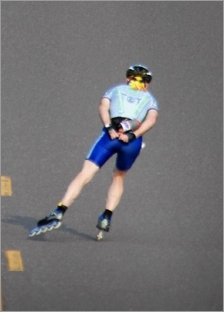 | ||
| ||||||||
How to Taper By Jim White
Tapering - Sometimes, you've got to go easy if you want to be strong. "All work and no play makes Jack a dull boy" ... and it could also hurt his performance on race day. How come? Because, as much as we resent it, we can't always go full tilt. We need to give our bodies some time to rebuild and recharge after periods of intense training. Athletes do this by "tapering" their workouts before events. Tapering routines vary from skater to skater. Some are quite elaborate and involve cutting back on workouts as much as a month in advance. Mine, on the other hand, is pretty simple. It's not right for everyone, but it works for me.' Pre-Taper Starting about a month before a big event, I train hard. I do lots of long distance skating, which builds up my base, and I work on technique. After a couple weeks, I shift my focus to interval training and sprints. (For indoor skaters, this is a good time to work on starts and passing drills.) I continue to train hard until the week before my race. If the race is on a Saturday, I do my last hard training session — going all out and with some emphasis on sprints — on the Sunday before. Taper Time Then I taper. On the Monday, Tuesday and Wednesday before a weekend event, I do what Bill Begg calls "floating 5Ks." These are easy 5-kilometer skates in which you imagine yourself flying or floating through the air. The idea is to loosen up your legs without stressing your muscles. At this point, it's too late to work on your technique. So just forget about it. If you're not satisfied with your technique (and who is?), plan to work on it after the race. Your mindset at this point should be: I've worked hard; I've done everything I can; now it's time to relax. Pre-Race During the last couple of days before a race, taper even more. If you skate at all, take it easy. Or do what I do: forget about skating. Go for an easy bike ride instead. And don't even think about the race. That will just make you nervous. If you can, arrive at the location of the race a couple days early. That way you'll have time to recover from the stress of traveling and you'll also be able to catch up with your race buddies, attend the expo and inspect the racecourse. Inspecting the racecourse is usually a good idea. It gives you a chance to look for potential trouble spots, such as potholes or tight turnarounds. Once you identify the problem spots, skate them three or four times. Of course, you won't be able to do this if the racecourse is on a busy highway. Skating the problem spots will get you ready for them on race day. Now you're ready for the race. If you've done a good job of tapering, you'll have fresh legs at the starting line. ... And poor Jack ... he'll be way behind you. ...
Jim White is a veteran skater on both road and ice. He skates indoors and outdoors as a member of Team Wisconsin and long- and short-track ice as a member of the West Allis Speed Skating Club. He is also the webmaster of Grow Inline Speed, a website that provides resources for the development of inline speed skating. He helps organize and produce skate races and is a regular contributor to inline skating forums.
Related reading: • Skate Tip of the Week Archive
...
Copyright © 2008 Inline Planet | ||||||||

